Home >> Diversity and classification >> True fungi >> Dikarya >> Basidiomycota >> Agaricomycotina >> Non-gilled macrofungi >> Tooth fungi
TOOTH FUNGI
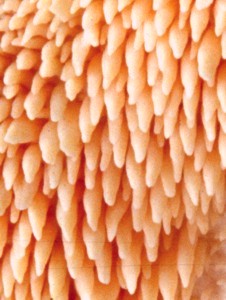
As their name implies, the tooth fungi bear their basidia and basidiospores on the surface of small teeth. The teeth are always oriented so that they will be exactly perpendicular to the earth. The teeth are also tapered, allowing the spores that are produced on their surface to fall straight down without a great likelihood of impacting on tissues further down the tooth.
A great many fungi have independently arrived at the tooth as an efficient way to release basidiospores into the environment. At one time it was believed that all of the tooth fungi were closely related and all were contained in the genus Hydnum. Tooday, using a variety of appraches we realize that this diversity is not an indication of natural relationships but rather one of similar approaches to ecological pressures.
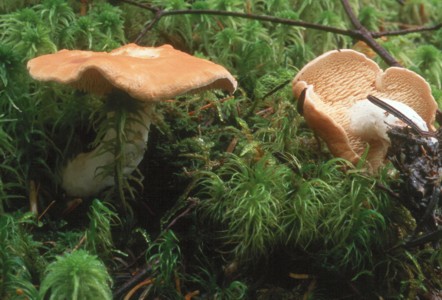
Hydnum repandum, the fungus in the picture at right (and also owner of the fine set of teeth at left), is a very common species in our region found growing under fir and spruce, usually in deep moss carpets. It has a typical mushroom shape and consistency and is really only different from a mushroom in producing its basidia on teeth instead of lamellae. As you can see in the picture it produces its basidiomata so that the teeth will point straight down.
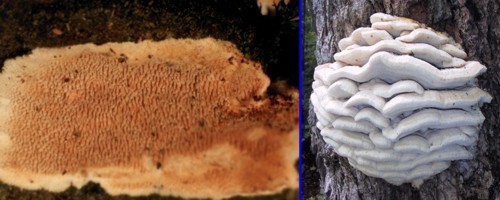
As we have seen the tooth fungi may produce their teeth on a typical stipitate mushroom, but their basidiomata can also be completely flat on the substrate (resupinate) or produced as shelving bracket fungi. In the picture at far left is a resupinate basidoma of Steccherinum ochraceum. It is produced on the underside of a dead hardwood branch and is only a centimeter or two in diameter. In contrast, the massive brackets of Climacodon septentrionale may form a cluster up to a meter in length. This impressive fungus is found on living maples and other deciduous trees where it is parasitic.

Phanerochaete chrysorhiza, above left, is another resupinate tooth fungus found on the underside of hardwood logs. This striking orange-red fungus produces numerous "ropes" of hyphae called rhizomorphs that connect one part of the substrate to another and probably act as nutrient conductors. This species is sometimes found in a sterile condition without teeth or with only a few scattered ones. The inset in the picture shows some of these teeth from the centre of the colony. Mucronella flava, above right, is about as uncomplicated as a tooth fungus can get. It occurs on old conifer logs as clustered teeth, with very little visible tissue connecting them.
Although the teeth of S. ochraceum, P. chrysorhiza and M. flava are quite apparent, some species have very low teeth that are hardly more than low bumps. Most such fungi are resupinate and you will be most likely to seek them out with the corticioid fungi. However, sometimes something truly intermediate comes to hand and you just have to try to identify it with more than one reference.
Most of our tooth fungi, at least the stiptate, mushroom-like ones, form mycorrhizae with forest trees. Several families and genera of these fungi are represented in our region and are commonly found. Illustrated below are a few of these.
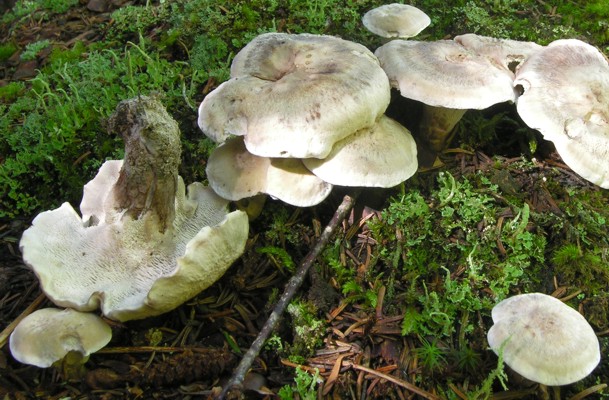
Bankera carnosa, a member of the Thelephorales, is frequently found growing under spruce or fir in moist coastal forests. Species of Bankera and the related genus Phellodon are notable for their peculiar odour of fenugreek, sometimes described as curry or even imitation maple. The odour, also known in some species of the mushroom genus Lactarius (Russulales), is most intense in dried specimens but can be detected even when they are fresh. Both Bankera and Phellodon have basidiospores that collect in a whitish mass when a spore print is made.
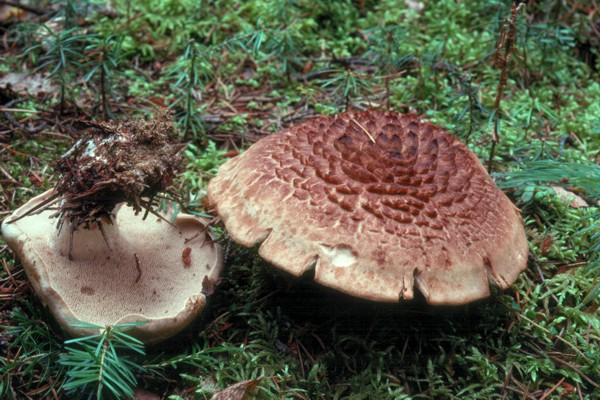
Sarcodon imbricatus is a fleshy tooth fungus similar to species of Bankera but lacking the fenugreek odour and having a brown spore print. Although S. imbricatus has a very scaly pileus some of the other Sarcodon species do not. Like Bankera, Phellodon and Hydnellum to follow, Sarcodon is a member of the Thelephorales.
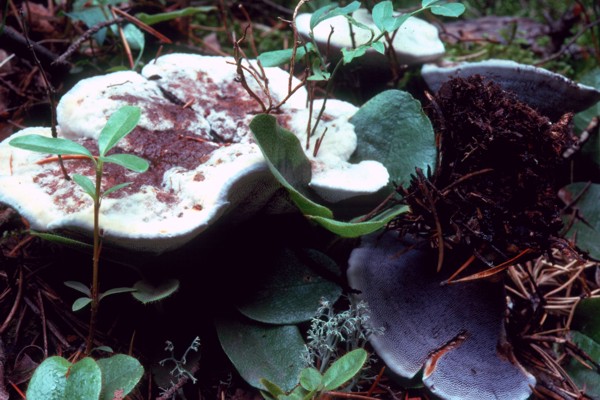
Hydnellum is the largest genus of stipitate tooth fungi and probably the most difficult for species identification. Hydnellum caeruleum, the species at left, is easier than most because of its striking blue basidiomata. In common with most species of Hydnellum it forms mycorrhizae with conifers. All of the species lack a fenugreek odour but may have a strong mealy or cucumber smell and all have a brown spore print. Species of Hydnellum are especially adept at incorporating other objects into their basidiomata by growing around them. When you collect them they will often be attached to plants, conifer needles and even rocks. Some of the small blueberry plants in the picture are surrounded by the tissues of the basidiomata. When they grow close to one another, as they often do, they may become confluent to form one large multi-stiped basidioma.
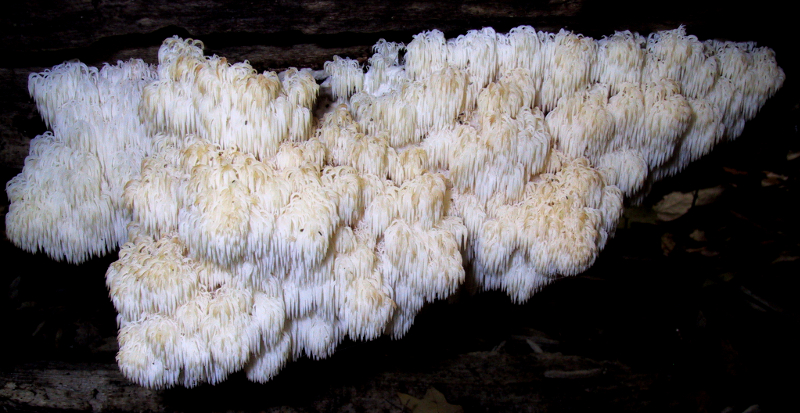
Species of Hericium differ from other tooth fungi in producing densely branched basidiomata with the teeth at the ends of the branches. These attractive fungi look like little balls of ice attached to the side of a log. They mostly grow on the dead wood of hardwood trees. Hericium coralloides, the fungus in the picture is a highly branched species found in hardwood forests throughout temperate regions of the world. Its white amyloid spores are typical of many Russulales.